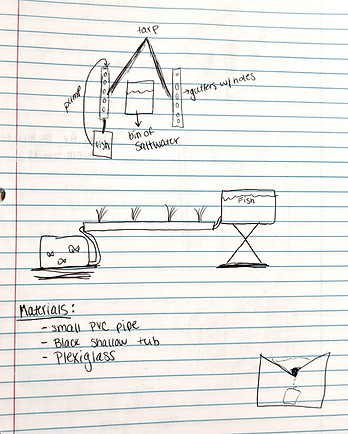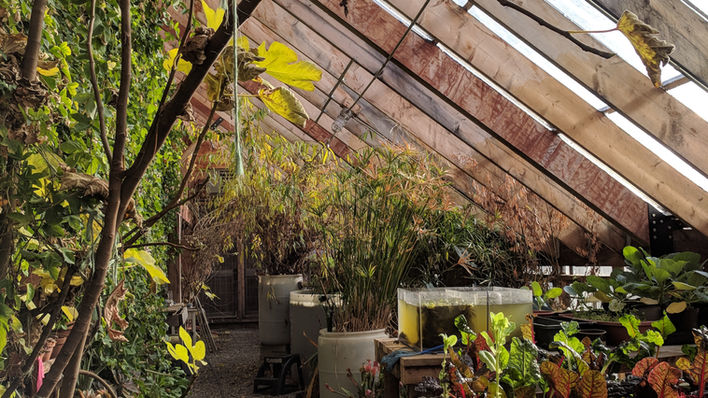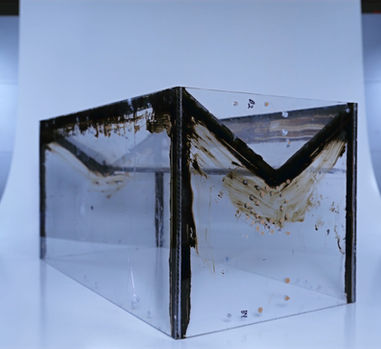Saltwater Greenhouse
Client
Location
Inaguain citizens
Inagua, Bahamas
Year
Services
2017-2018
Problem definition,
human centered design, prototyping, user experience

This group project was a response to information from an engineer living and working in Inagua. The task was to solve a problem for the people of Inagua in a socially responsible way. The only constraint on this project was to have a prototype by the deadline. My group came up with an evaporative saltwater greenhouse to solve the problem of a lack of fresh food on the island by taking advantage of their abundance of saltwater. My team was awarded a $10,000 grant to continue developing this solution.
Research
Initial documents providing background information about Inagua were given to each student. These were very general documents aiming to give a bit of insight to life on Inagua and challenges they face.
After going over this initial information, I knew I wanted to focus on sustainability and the challenges of getting fresh produce to the island. I did further research online related to this topic. Based on this research and sending questions to Mark Klein, an engineer in Inagua, my group and I came up with the following problem definition.
background info
Problem Definition
When crafting the problem definition, my group and I took an iterative approach. We laid out the problem as we saw it after thorough research, and tried to brainstorm a sentence or two that could frame the problem in a way that invites us to explore solutions later on. We wanted to make sure we had a clear problem to solve to guide us through the design process.
While "problem definition" seems so permanent, I like to look at it as fluid guidelines to help you down a path for further research. I found that we went through iterations of the problem definition due to further insight to the problem from research or interviews. Our final problem definition is shown on the left.
Brainstorming
After determining the problem and doing another round of research, we took to the drawing board to try and brainstorm some potential solutions.
Here are some ideas we came up with:
-
Rainfall water capture system and irrigation
-
Fixing soil - plants to revitalize the soil
-
Plants that can grow in salt water
-
Potatoes and tomatoes
-
-
The saltwater greenhouse (use water cycle to desalinate water)
We decided to move forward with the idea of a saltwater greenhouse. We analyzed a handful of potential solutions and saw the most value in this idea. It would allow the Inaguaians the most variety of food and had the potential to also be a source of drinking water.
brainstorm document
My group decided to use Google docs for this project due to its collaborative capability among ourselves and with our teacher. Above is our brainstorming document complete with typos and all.


concept sketch 1
Here's my original sketch of an aquaponics system that could desalinate salt water.

concept sketch 2
Here are some sketches of how the greenhouse would work with an inverted roof that would catch rainwater and cool the roof to promote condensation inside.
Field Research
I also got to do some incredible field research for this project. My team, professor, and I got to go visit the Radix Center in Albany, NY. This is a center that aims to teach the community that there is often a better, more sustainable way to do things and to be environmental stewards. They emphasize sustainable solutions for food scarcity and health which was right in line with our project. At the Radix Center, they have a greenhouse that has been optimally designed for sunlight, heating, and ventilation. The Radix Center taught my team about optimizing a greenhouse and different methods of growing food, like aquaponics.
radix center
Prototyping
Now that we had settled on an idea, it was time to explore it further with some prototypes. We started by making the inverted roof structure out of leftover plexiglass we found in the studio. Our goal for this prototype was to prove that our concept of desalination could work. To do that we had to simulate the conditions the greenhouse would be under. Using a heat lamp as the sun, and a fan as the prevailing winds, we were able to prove our concept. Now we had to iterate and optimize.
Throughout the whole project, we always went back to the research phase to learn as much as we could. We ended up finding an open-source model that someone came up with for desalinating water. We decided to build it to understand it better and to test its efficiency.
prototype 2
This was an open source design that we found online. We decided to build it to learn more how it works and to compare its efficiency to our design. You can see a stage light mimicking the sun and a fan to simulate the prevailing winds.

Our first dome was a low-fidelity prototype built from paper which was a quick and easy way for my team and I to learn about the geometry on the dome and how to put it together.
We quickly moved onto assembling a fourth prototype keeping the geodesic shape but changing the material to clear acrylic.

prototype 4
Here's our clear acrylic geodesic dome model. We marked the different triangles with red, blue, or nothing for easier construction. However, we ended up with some cracks which would skew any test results.
Our last prototype was made from metal conduit and 3-D printed hubs found on Thingiverse. Since we now knew how big the plot of land was, we knew how big the dome could be so we made our prototype to scale.
prototype 5
Here is the constructed frame of the scaled down prototype. We tied the bottom together for structural integrity while we were building.

prototype 1
I know what your thinking... gross. Yes it is true that the black waterproof epoxy did not go over well aesthetically. But, it was what was on hand and it got the job done; we were able to prove our concept.
After running some tests. We learned that a pipe system, like the one leading to the water jug in the second prototype, would be needed for efficient water collection.
For our next iteration, we went with a geodesic dome as the structure. This decision was based on research about the weather in Inagua. They are prone to hurricanes so in order to become a reliable source of water, we needed a structure that would hold up to strong winds.

prototype 3
Here is our paper geodesic dome. It is made up of 3 different triangles that are difficult to distinguish from each other so putting it together was like a 3D puzzle.
Our intention was to use the acrylic version to test how much water we could desalinate using this shape and to study how we could increase our yield.
However, after building it, there wasn't a good seal between the triangles so our testing would not be accurate due to water loss. We needed a better way to build it.
At this point we were told we could use a plot of land in Inagua and had an idea of how big the geodesic dome could be. We decided to make a scale model for more accurate testing.
prototype 5

This is a close up of one section of the geodesic dome. You can see how the 3D printed hubs work by inserting them into the metal conduit I cut in our metal shop.
The goal behind this prototype was to repeat the tests by evaporating saltwater to understand where the condensation occurs, the best way to collect that condensation, and how to optimize the amount of fresh water produced. Our next steps would be to wrap the structure with a plastic wrap to mimic the glass that would make up the structure.
Results
With the culmination of our advisor leaving our school, as well as taking on our two senior projects, my team decided not to pursue the project passed the Spring 2018 semester.
During our time together we were able to design a prototype, prove our concept, and have the backing of a professional engineer in Inagua. We secured the Burt Swersey Challenge Studio $10,000 grant which allowed us to develop and build something that we were all so passionate about.
This project taught me a lot about communication and how to say no. It also taught me valuable time and self-management skills. The team I worked with was incredible and I hope to work with them again in the future.
















